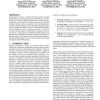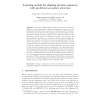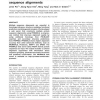122 search results - page 3 / 25 » Protein Fold Recognition using Residue-Based Alignments of S... |
BCB
2010
13 years 2 months ago
2010
In this paper we present a method for flexible protein structure alignment based on elastic shape analysis of backbones, in a manner that can incorporate different characteristics...
RECOMB
2009
Springer
14 years 8 months ago
2009
Springer
Accurately aligning distant protein sequences is notoriously difficult. A recent approach to improving alignment accuracy is to use additional information such as predicted seconda...
BMCBI
2008
13 years 7 months ago
2008
Background: Nonnegative matrix factorization (NMF) is a feature extraction method that has the property of intuitive part-based representation of the original features. This uniqu...
JCB
2006
13 years 7 months ago
2006
Protein fold recognition is an important step towards understanding protein three-dimensional structures and their functions. A conditional graphical model, i.e., segmentation con...
NAR
2007
13 years 7 months ago
2007
Multiple sequence alignments are essential in homology inference, structure modeling, functional prediction and phylogenetic analysis. We developed a web server that constructs mu...



